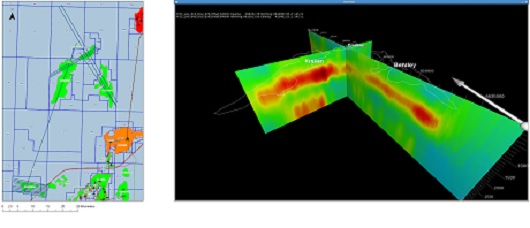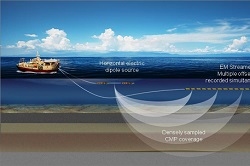 Figure 1. Schematic of the Towed Streamer EM system.
Figure 1. Schematic of the Towed Streamer EM system.
Meld deg på EM-konferansen her
Over the past 10 years we have seen the development of the marine Controlled Source Electromagnetic (CSEM) method for hydrocarbon exploration.
The survey method exploits the increased electrical resistivity of hydrocarbon-saturated rocks to detect likely accumulations of gas or oil in the subsurface. Subsurface resistivitiy can be measured by providing a strong EM field from an electric dipole source, and placing receiver electrodes some distance away.
The EM field propagates through the water column and into the subsurface, and the measurements at the receivers can be used to determine the resistivity at various locations and depths. The use of a man-made source distinguishes Controlled Source EM techniques from others that utilize natural magnetotelluric variation in the earth’s magnetic field commonly known as the MT method.
The most widely used CSEM technique involves placing receiver equipment into individual remotely powered units called nodes. An array of nodes is placed on the seabed and the dipole source is then towed in a regular grid or along specific survey lines. During the survey the node units record the received data, which is recovered after the nodes are released back to the surface once data acquisition is complete.
The most favorable targets for node based systems are in deep water, where noise levels are low, and the economic incentive of very expensive wells make node based CSEM and attractive option to de-risk investment.
Node deployment and retrieval is a time consuming business, and there is consequently a strong economic driver to acquire EM data more efficiently. The seismic method has been transformational in its impact on oil and gas exploration. If we look at how marine seismic technology has evolved over the years we see ever more streamers being deployed, and data being acquired more densely and more rapidly than ever thought possible in the early days.
Node based seismic technology is also available, but we see the cost of acquiring data in this way is often prohibitive. Thus seismic nodes are deployed for relatively few special cases where specific technical requirements or obstructions rule out the towed option.
There are obvious economic advantages to be gained if a similar approach could be adopted in the development of CSEM where the receiver array could be encapsulated in a towed semi-buoyant streamer (Figure 1).
The main obstacle to developing a towed streamer electromagnetic system is the presence of EM noise. Towing receivers that are minutely sensitive to variations in the EM field means that they are subject to induced noise. Efficient towing requires that the receivers are currently within 100m of the sea surface which means they are exposed to the natural fluctuations in the earth’s magnetic field which is in our case regarded as magnetotelluric (MT) noise.
In spite of these fundamental issues, the cost advantages of a towed streamer electromagnetic system would clearly make it economically viable for use in shallower waters on the continental shelf where budgets may be less likely to support a node-based approach.
 Figure 2. 2012 Program Map Figure 3. Preliminary inversion showing resistive anomalies that coincide with the Bentley, Kraken and Bressay reservoirs.
Figure 2. 2012 Program Map Figure 3. Preliminary inversion showing resistive anomalies that coincide with the Bentley, Kraken and Bressay reservoirs.
Can a Towed Streamer EM System really deliver valuable information? There has been a great deal of speculation as to whether the noise issues can be overcome effectively. This has prompted several test surveys and the publication of numerous papers on the subject.
The PGS Towed Streamer EM system has been designed with several key features to overcome noise and to achieve the necessary signal-to-noise ratio for effective surveying. Based on survey results collected last autumn, the results indicate that the proof of concept has already been achieved.
Data is now published from several cases in the North Sea representing a range of settings. These cases have allowed work to progress on processing and inversion techniques, investigations into electrical anisotropy, and the use of synthetic aperture techniques to improve target sensitivity.
Data was acquired during 2012 in and around the North Viking Graben (see Map Figure 2). Preliminary data examples (Figure 3) from the survey, suggest that the Towed Streamer Electromagnetic system can provide an effective solution to EM surveying with results available from several known Shelf-Sea fields. The data was acquired by the PGS Seismic vessel “Nordic Explorer” that has been enabled for EM operations. A single 8Km EM streamer was towed behind an 800m Bi-Pole source operating at +/- 1500A. According to PGS, several oil companies are evaluating the technology for 2013 EM surveys.
PGS has been working on a Towed Streamer EM system since 2004. In 2010 towed surveys were conducted in the North Sea, over Statoil’s Peon discovery (PL 318). The system was further tested on a deeper target over the Troll gas field (PL 054 & 085). In each case data clearly indicated the presence of the gas reservoirs by detection of their resistive anomalies.
These were compared to detailed resistivity models created from well data, seismic data and iterative 3D forward EM modeling. Further to the technical results it should also be noted that robustness and equipment handling was tested in heavy seas. Data was acquired at a speed of around 4- 5 knots, similar to the rate at which seismic data can be acquired.
The next step is to implement simultaneous seismic and EM acquisition where a seismic array and an EM array are towed simultaneously from the same vessel.



